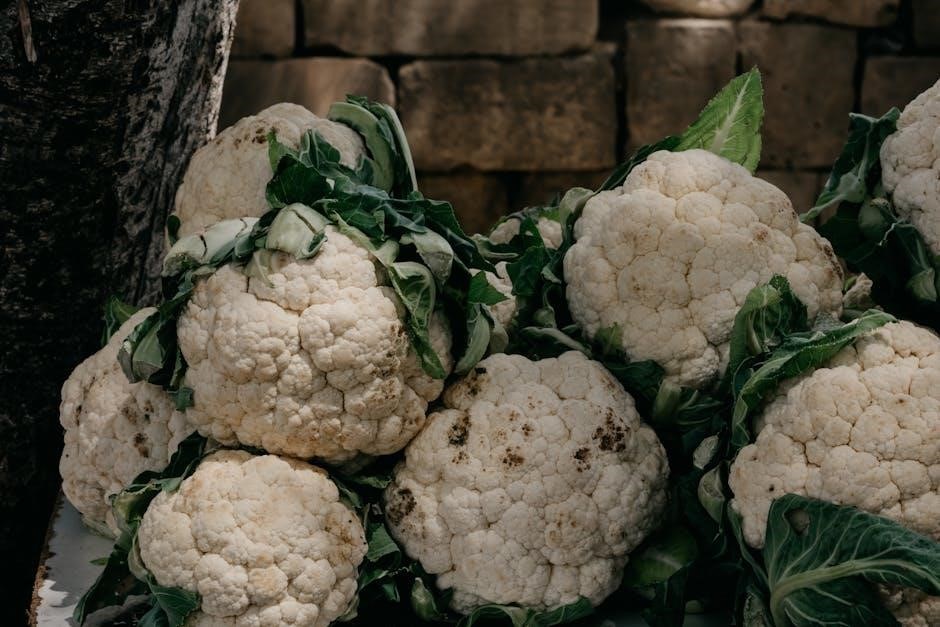Cruciferous vegetables belong to the Brassicaceae family, characterized by their cross-shaped flowers. These nutrient-dense plants are renowned for their health benefits and culinary versatility worldwide.
1.1 Definition and Characteristics
Cruciferous vegetables are part of the Brassicaceae family, characterized by their distinctive cross-shaped flowers. These plants are known for their high nutrient density, rich in vitamins, minerals, and fiber. They contain unique phytochemicals like isothiocyanates and indoles, which contribute to their health benefits. Cruciferous vegetables are versatile in culinary applications, offering a variety of textures and flavors. They are typically cool-season crops, thriving in temperate climates. Examples include broccoli, kale, and cabbage. Their leaves, stems, and roots are edible, making them a diverse group for culinary use. Cruciferous vegetables are also noted for their potential to support detoxification and immune function, due to their sulfur-containing compounds. They are a key component of a balanced diet, providing essential nutrients and bioactive properties. Regular consumption is encouraged for overall health and wellness. Proper preparation, such as steaming or light cooking, helps retain their nutritional value.
1.2 Common Examples of Cruciferous Vegetables
Common examples of cruciferous vegetables include broccoli, cauliflower, kale, cabbage, Brussels sprouts, and arugula. These vegetables are widely recognized for their nutritional value and versatility in various cuisines. Broccoli, for instance, is rich in vitamin C and fiber, while kale is known for its high vitamin A content. Cabbage and Brussels sprouts are excellent sources of antioxidants, and arugula adds a peppery flavor to salads. Other notable examples are bok choy, collard greens, and mustard greens; These vegetables are not only delicious but also provide numerous health benefits, making them a popular choice for health-conscious individuals. Their availability in different forms, from leafy greens to root vegetables, ensures a wide range of culinary uses. Incorporating these into meals can enhance both flavor and nutritional intake.
Health Benefits of Cruciferous Vegetables
Cruciferous vegetables offer numerous health benefits, including cancer prevention, cardiovascular support, and detoxification. They are rich in vitamins, fiber, and phytochemicals, promoting overall well-being and disease resistance.
2.1 Cancer Prevention and Anticancer Properties
Cruciferous vegetables are rich in compounds like sulforaphane and indoles, which have potent anticancer properties. These phytochemicals help detoxify harmful substances and inhibit cancer cell growth. Studies suggest that consuming cruciferous vegetables may reduce the risk of breast, prostate, and colon cancers. Additionally, they contain isothiocyanates, which can induce apoptosis in cancer cells. The ability of these vegetables to modulate estrogen metabolism further contributes to their cancer-preventive effects. Regular inclusion of cruciferous vegetables in the diet is a simple yet effective way to harness their anticancer potential and support overall health.
2.2 Support for Cardiovascular Health
Cruciferous vegetables are rich in nutrients that support cardiovascular health. High in fiber, they help lower cholesterol levels, reducing the risk of heart disease. Vitamins C and K, along with potassium, promote healthy blood vessel function and regulate blood pressure. The antioxidants and anti-inflammatory compounds in these vegetables also protect against vascular damage and inflammation, which are linked to cardiovascular diseases. Regular consumption of cruciferous vegetables like broccoli, kale, and Brussels sprouts can contribute to improved heart health by maintaining healthy blood flow and preventing hypertension. Their nutrient-dense profile makes them a valuable addition to a heart-healthy diet, supporting overall well-being and reducing the risk of cardiovascular conditions.
2.3 Role in Detoxification and Immune Support
Cruciferous vegetables play a significant role in detoxification and immune support due to their high content of phytochemicals. Compounds like isothiocyanates and indoles help activate detoxification pathways, aiding the body in eliminating harmful substances. These vegetables are also rich in vitamins C and E, which strengthen the immune system by protecting cells from oxidative damage. Additionally, their fiber content supports healthy digestion, which is crucial for immune function. The antioxidants in cruciferous vegetables further enhance immune response, reducing inflammation and fostering overall well-being. Regular consumption of broccoli, kale, and other cruciferous varieties can bolster the body’s natural detoxification processes and provide robust immune support, making them a vital component of a health-promoting diet.
2.4 Impact on Thyroid Function and Hormone Balance
Cruciferous vegetables contain compounds like goitrogens, which can influence thyroid function by potentially interfering with iodine uptake, especially in individuals with iodine deficiency. Overconsumption may contribute to hypothyroidism or goiter, but moderate intake is generally safe. These vegetables also support hormone balance through their rich nutrient profile, including vitamins and minerals that aid in overall endocrine health. While they may impact thyroid function, they are not inherently harmful when consumed as part of a balanced diet. However, individuals with thyroid conditions should consult healthcare professionals to manage their intake effectively, ensuring they reap the benefits without adverse effects.
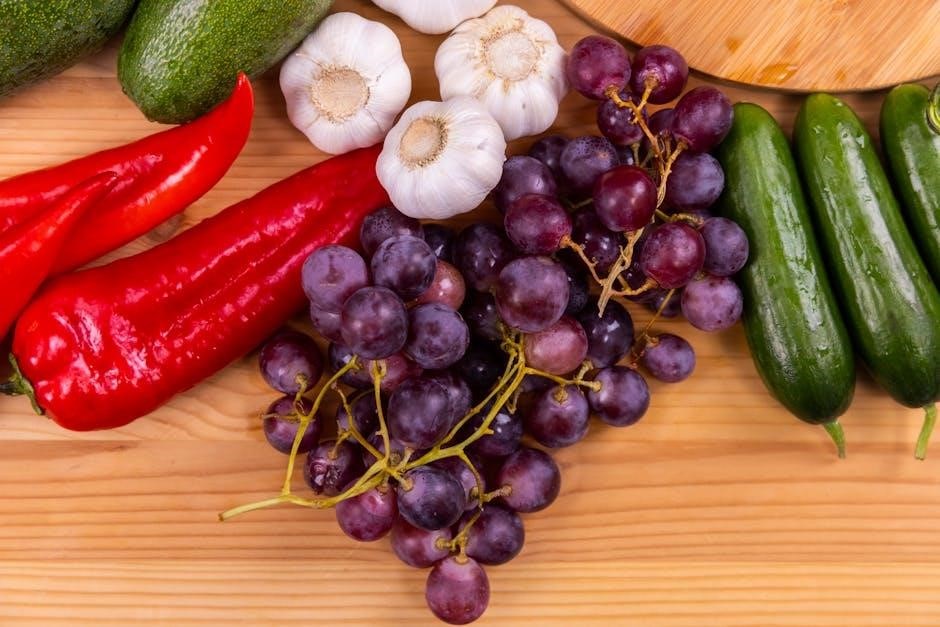
Nutritional Value of Cruciferous Vegetables
Cruciferous vegetables are rich in vitamins A, C, and K, fiber, and minerals like manganese. They also contain phytochemicals, supporting digestion, immunity, and overall health.
3.1 Vitamins and Minerals Content
Cruciferous vegetables are packed with essential vitamins and minerals, including vitamin C, which boosts immunity, and vitamin K, crucial for blood clotting. They are also rich in folate, supporting cell growth, and manganese, important for bone health. Additionally, these vegetables provide significant amounts of vitamin A, promoting eye health, and vitamin E, acting as an antioxidant. Minerals like calcium and iron are present, contributing to strong bones and healthy red blood cells. The diverse nutrient profile makes them a valuable addition to a balanced diet, offering numerous health benefits with minimal caloric content.
3.2 Fiber and Digestive Health Benefits
Cruciferous vegetables are an excellent source of dietary fiber, which plays a crucial role in maintaining healthy digestion. Fiber helps regulate bowel movements, preventing issues like constipation and diarrhea. These vegetables also promote the growth of beneficial gut bacteria, enhancing overall gut health. The fiber content in broccoli, Brussels sprouts, and kale can improve satiety, aiding in weight management. Additionally, the antioxidants present in these vegetables reduce inflammation in the digestive tract, further supporting a healthy digestive system. Incorporating cruciferous vegetables into your diet is a simple yet effective way to boost fiber intake and maintain optimal digestive function.
3.3 Phytochemicals and Their Importance
Cruciferous vegetables are rich in phytochemicals, particularly isothiocyanates and indoles, which are potent antioxidants. These compounds are known to neutralize harmful free radicals, protecting cells from oxidative damage. Isothiocyanates, such as sulforaphane found in broccoli, have been linked to anti-inflammatory and anticancer properties. Indole-3-carbinol (I3C) supports hormone balance and enhances immune function. Phytochemicals in these vegetables also activate detoxification pathways, aiding the body in eliminating harmful substances. Additionally, they may inhibit the growth of cancer cells and reduce the risk of chronic diseases. The unique combination of phytochemicals in cruciferous vegetables makes them a vital component of a health-promoting diet, offering comprehensive protection against various health challenges.
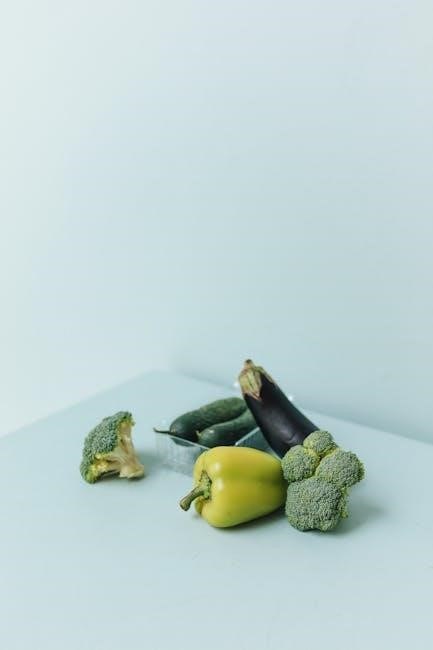
Comprehensive List of Cruciferous Vegetables
Cruciferous vegetables include broccoli, kale, cabbage, cauliflower, Brussels sprouts, arugula, bok choy, collard greens, turnips, radishes, mustard greens, watercress, and rutabaga, offering diverse flavors and nutrients.
4.1 Common Cruciferous Vegetables
Common cruciferous vegetables include broccoli, cauliflower, kale, cabbage, Brussels sprouts, arugula, bok choy, collard greens, turnips, radishes, mustard greens, watercress, and rutabaga. These vegetables belong to the Brassicaceae family and are widely recognized for their nutritional value and versatility in recipes. Broccoli, kale, and Brussels sprouts are particularly popular for their high vitamin and mineral content, while cabbage and cauliflower are staples in many cuisines. Arugula and watercress add peppery flavors to salads, making them ideal for fresh dishes. Root vegetables like turnips and radishes provide a crunchy texture and are rich in fiber. These vegetables are not only delicious but also packed with phytochemicals, making them a healthy addition to any diet. Their availability in various forms ensures they can be incorporated into meals year-round.
4.2 Leafy Greens and Their Varieties
Leafy greens within the cruciferous family include kale, collard greens, mustard greens, and arugula, each offering distinct flavors and textures. Kale, available in curly, lacinato, and red varieties, is rich in vitamins A, C, and K. Collard greens, with their large, flat leaves, are a staple in Southern cuisine and are known for their mild taste and high calcium content. Mustard greens, slightly bitter, are versatile in soups and sautés. Arugula adds a peppery kick to salads, making it a favorite in fresh dishes. These greens are nutrient-dense, providing essential minerals and antioxidants that support overall health. Their versatility allows for various culinary uses, from raw salads to cooked meals, enhancing both flavor and nutrition in diverse recipes. Incorporating these leafy greens into meals offers numerous health benefits and culinary possibilities.
4.3 Root and Stem Vegetables in the Cruciferous Family
Root and stem vegetables in the cruciferous family include turnips, rutabagas, radishes, kohlrabi, and daikon. These vegetables are known for their robust flavors and versatile uses in cooking. Turnips and rutabagas, often used in soups and stews, offer a sweet, earthy taste. Radishes, with their spicy kick, are commonly eaten raw or pickled. Kohlrabi, resembling a cabbage stem, has a mild, slightly sweet flavor and is used in salads or roasted. Daikon, a large white radish, is popular in Asian cuisine for its crunchy texture and mild taste. These root and stem vegetables are rich in vitamins, minerals, and antioxidants, making them a nutritious addition to a balanced diet. Their diversity in texture and flavor enhances various culinary dishes, from savory meals to fresh salads.
4.4 Specialty and Less Common Cruciferous Vegetables
Specialty cruciferous vegetables include lesser-known varieties like komatsuna, mizuna, and land cress. Komatsuna, a Japanese mustard spinach, offers a mild mustard flavor and is used in salads or cooked dishes. Mizuna, with its delicate, slightly bitter taste, is often found in Japanese and Asian cuisines. Land cress, also called American cress, has a peppery flavor and is used in salads or as a garnish. Other less common varieties include tatsoi, a small, spoon-shaped Asian green with a buttery texture, and mustard greens, which have a robust, earthy flavor. These vegetables add unique dimensions to meals and are rich in vitamins, minerals, and antioxidants, making them valuable additions to a diverse diet. They are also versatile in both raw and cooked applications.
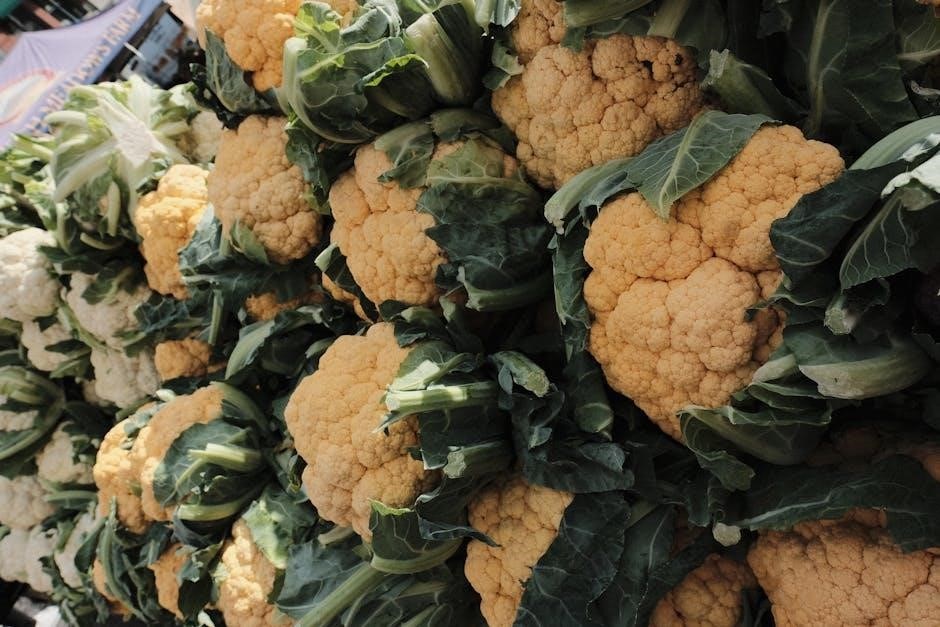
Culinary Uses of Cruciferous Vegetables
Cruciferous vegetables are versatile in various cuisines, used raw in salads, sautéed, steamed, or roasted. They add texture and flavor to dishes, enhancing both nutrition and taste.

5.1 Incorporating Cruciferous Vegetables into Meals
Cruciferous vegetables can be easily incorporated into meals for added nutrition and flavor. They are versatile and can be enjoyed raw in salads, sautéed as a side dish, or roasted for a caramelized taste. Adding them to soups, stir-fries, and casseroles enhances both texture and nutrient density. For example, kale can be massaged with olive oil for a tender salad base, while broccoli and Brussels sprouts can be roasted with garlic for a crispy snack. Incorporating these vegetables into omelets, wraps, or pasta dishes is another great way to boost meals. Experimenting with different cooking methods and seasonings can make cruciferous vegetables a delightful and healthy addition to any diet. Their mild to bold flavors adapt well to various cuisines, ensuring they fit seamlessly into any meal plan.
5.2 Cooking Methods for Maximum Nutrient Retention
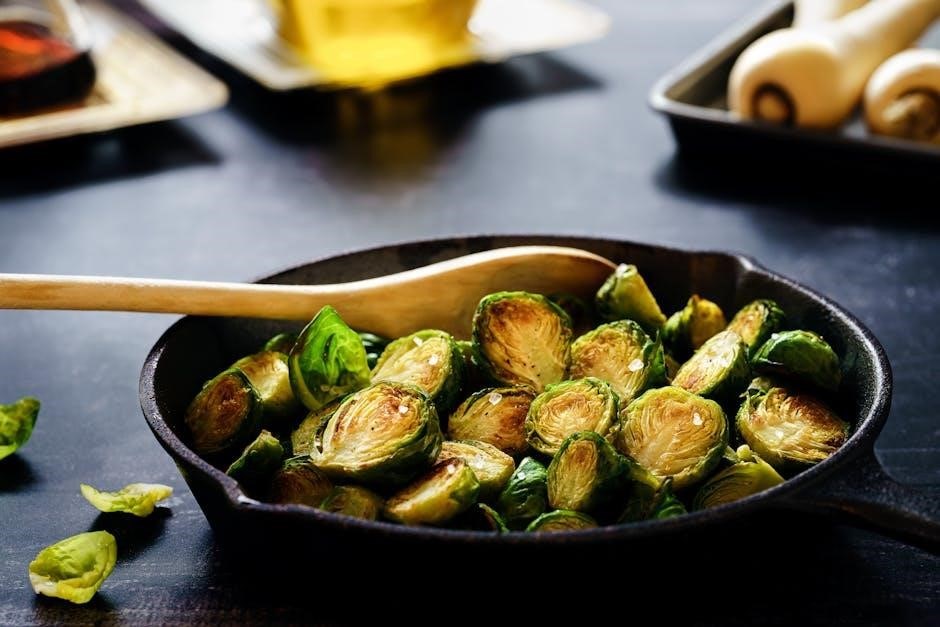
Cooking cruciferous vegetables requires careful techniques to preserve their nutrient content. Steaming is highly recommended, as it helps retain water-soluble vitamins like vitamin C and B vitamins. Roasting and sautéing with minimal water and time also preserve nutrients effectively. Light cooking enhances bioavailability of compounds like sulforaphane in broccoli. Overcooking should be avoided, as it can lead to a loss of vitamins and phytochemicals. For maximum benefit, these vegetables can be consumed raw, as chopping or chewing activates their bioactive compounds. Proper cooking methods ensure that cruciferous vegetables remain a nutritious and flavorful addition to meals, maintaining their health-promoting properties while enhancing their natural flavors.
5.3 Tips for Reducing Bitterness and Enhancing Flavor
Cruciferous vegetables can sometimes have a bitter taste, but simple techniques can enhance their flavor. Balancing bitterness with acidity, such as adding lemon juice or vinegar, helps neutralize harsh notes. Pairing these vegetables with sweet or savory ingredients, like garlic or ginger, can also enhance their palatability. Roasting brings out natural sweetness, reducing bitterness, while sautéing with olive oil and herbs adds depth. For stronger-flavored varieties, pairing with creamy elements like cheese or yogurt can balance the taste. Experimenting with seasoning and complementary flavors makes cruciferous vegetables more enjoyable and versatile in various dishes.
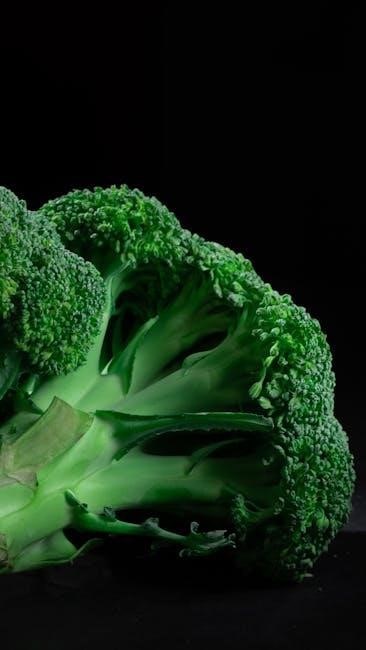
Tips for Selecting and Storing Cruciferous Vegetables
Choose cruciferous vegetables that are firm and vibrant, avoiding wilted or discolored leaves. Store them in the refrigerator to maintain freshness, using airtight containers. Handle gently to prevent damage, and wash before use to ensure safety and quality.
6.1 How to Choose Fresh Cruciferous Vegetables
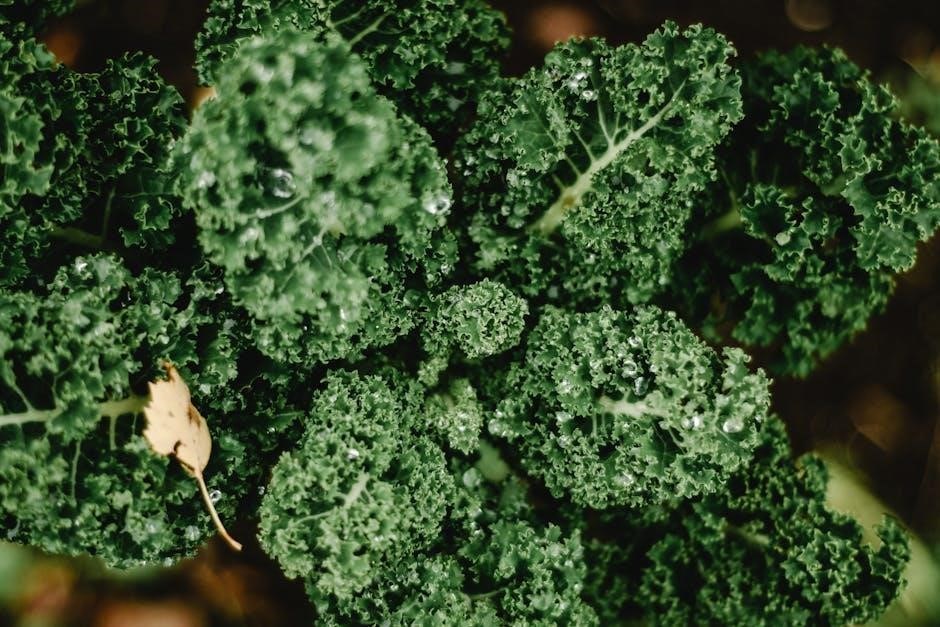
When selecting fresh cruciferous vegetables, look for firm, vibrant leaves and sturdy stems. Avoid wilted, discolored, or damaged produce, as these signs indicate spoilage. For vegetables like broccoli and cauliflower, choose those with tightly packed florets and no visible yellowing. Leafy greens such as kale and collard greens should have crisp, evenly colored leaves without brown spots. Check for a fresh, earthy aroma and avoid vegetables with a sour or unpleasant smell. Opt for seasonal produce, as it is typically fresher and more nutritious. Always rinse vegetables before use to ensure cleanliness and food safety. Proper selection ensures maximum flavor and nutritional benefits.
6.2 Storage Methods to Maintain Freshness
To keep cruciferous vegetables fresh, store them in a cool, dry place or refrigerate promptly. Use airtight containers or breathable bags to maintain humidity and prevent moisture buildup. Leafy greens like kale and spinach can be stored in sealed containers with paper towels to absorb excess moisture. Root vegetables such as turnips and radishes fare well in the crisper drawer, while broccoli and cauliflower should be kept dry and refrigerated. Avoid washing before storage, as excess moisture can lead to spoilage. Most cruciferous vegetables remain fresh for 3–7 days when stored properly. For longer storage, consider freezing, but blanching is recommended to preserve nutrients and texture. Proper storage ensures optimal flavor and nutrient retention.
6.3 Food Safety and Handling Practices
Proper handling and storage are crucial for maintaining the safety and quality of cruciferous vegetables. Always wash hands before and after handling vegetables. Rinse cruciferous vegetables under clean, running water just before use to remove dirt and potential contaminants. Use clean utensils and cutting boards to prevent cross-contamination. Avoid using soiled or damaged vegetables, as they may harbor harmful bacteria. Cook cruciferous vegetables thoroughly to an internal temperature of at least 165°F (74°C) if cooking is required. For raw consumption, ensure they are fresh and free of visible spoilage. Regularly clean and sanitize storage containers and utensils. Proper food safety practices help prevent foodborne illnesses and ensure maximum nutritional benefits from cruciferous vegetables.
The Importance of a Cruciferous Vegetables List in PDF Format
A PDF list of cruciferous vegetables offers convenience, portability, and accessibility, making it easier to plan meals, shop efficiently, and stay informed about their benefits.
7.1 Accessibility and Portability of PDF Guides
PDF guides featuring lists of cruciferous vegetables are highly accessible and portable, making them ideal for quick reference. These documents can be easily downloaded and viewed on various devices, including smartphones, tablets, and computers, without requiring special software. Their portability allows users to carry them while grocery shopping or meal planning, ensuring that healthy choices are always within reach. The compact format of PDFs also makes them easy to share and print, adding to their convenience. Additionally, PDF guides are often well-organized, with clear headings and sections, making it simple to navigate and find specific information quickly. This accessibility and portability make PDF guides a practical tool for incorporating cruciferous vegetables into daily diets.
7.2 Convenience for Meal Planning and Grocery Shopping
A PDF guide featuring a list of cruciferous vegetables offers unparalleled convenience for meal planning and grocery shopping. By having a comprehensive list in a portable format, users can easily plan balanced meals and create organized grocery lists. The ability to mark or highlight favorite vegetables ensures that shoppers never miss an item. Additionally, PDF guides often include images and descriptions, helping consumers identify less familiar varieties at the store. This convenience extends to meal preparation, as users can quickly reference the list for recipe ideas or substitution suggestions. The organized structure of PDF guides streamlines the process of incorporating cruciferous vegetables into daily meals, making healthy eating both accessible and efficient. This level of organization is a valuable asset for anyone aiming to maintain a nutritious diet.
7.3 Customization Options for Personalized Nutrition Plans
A PDF list of cruciferous vegetables offers extensive customization options, making it ideal for tailored nutrition plans. Users can highlight or annotate specific vegetables based on personal preferences or dietary needs. For instance, individuals managing thyroid health can focus on vegetables with balanced goitrogen content. The portability of PDF guides allows for easy updates, enabling users to adjust their lists as their nutrition goals evolve. Additionally, the ability to categorize vegetables by their health benefits, such as cancer prevention or detoxification support, simplifies meal planning. This flexibility ensures that the guide remains a dynamic tool, adapting to individual lifestyles and health requirements while promoting long-term wellness.
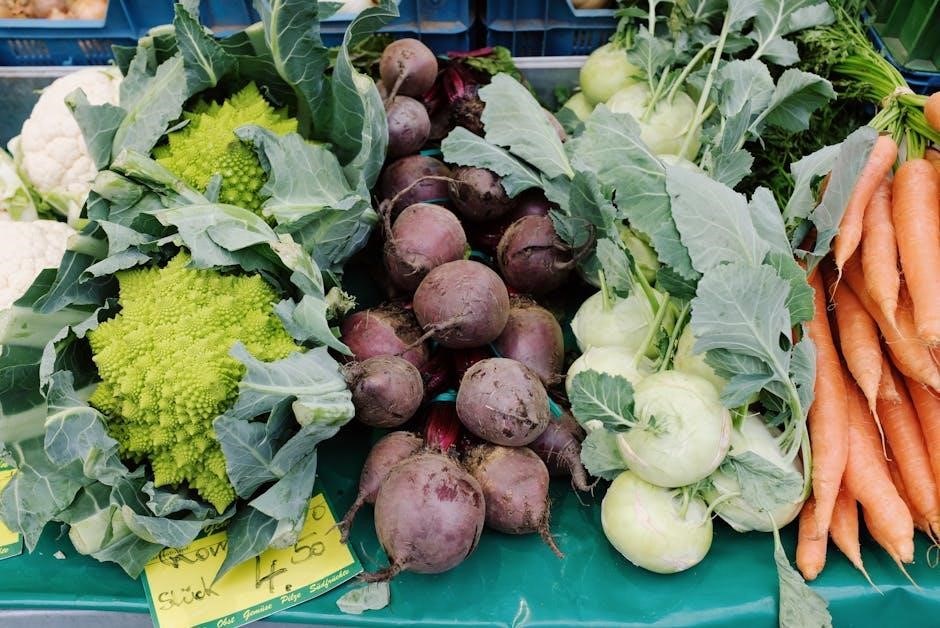
Cruciferous vegetables offer exceptional health benefits, versatility, and nutritional value. Incorporating them into your diet can enhance overall wellness. Use a PDF list to easily reference and plan meals.

8.1 Summary of Key Points
Cruciferous vegetables, part of the Brassicaceae family, are rich in nutrients, fiber, and phytochemicals like sulforaphane, offering numerous health benefits. They play a role in cancer prevention, support cardiovascular health, aid detoxification, and influence thyroid function. High in vitamins A, C, K, and minerals, these vegetables are versatile in culinary applications. A PDF list of cruciferous vegetables provides easy access to information, helping with meal planning and grocery shopping. Incorporating varieties like broccoli, kale, and Brussels sprouts can enhance dietary diversity and promote overall well-being. Their ability to support immune function and digestive health makes them a valuable addition to a balanced diet. Utilizing a comprehensive PDF guide ensures convenience and customization for personal nutrition plans.
8.2 Encouragement to Incorporate Cruciferous Vegetables
Incorporating cruciferous vegetables into your diet is a simple yet impactful way to enhance your health and well-being. These vegetables are not only nutrient-dense but also versatile, making them easy to add to meals. With their rich content of vitamins, minerals, and phytochemicals, they support cancer prevention, cardiovascular health, and immune function. Using a PDF guide can simplify meal planning and grocery shopping, ensuring you never run out of options. Whether raw, steamed, or sautéed, cruciferous vegetables offer a delicious way to improve your diet. Start exploring the diverse flavors and textures of broccoli, kale, Brussels sprouts, and more to experience the benefits firsthand. Make them a staple in your kitchen for a healthier, more balanced lifestyle.
